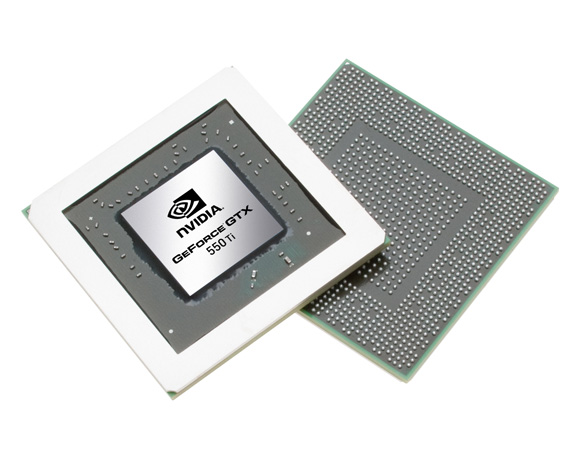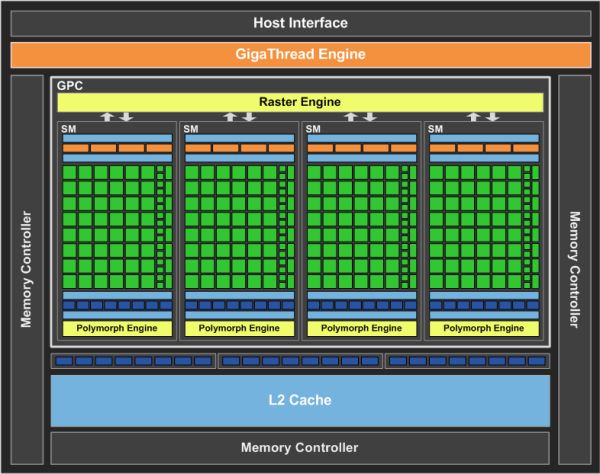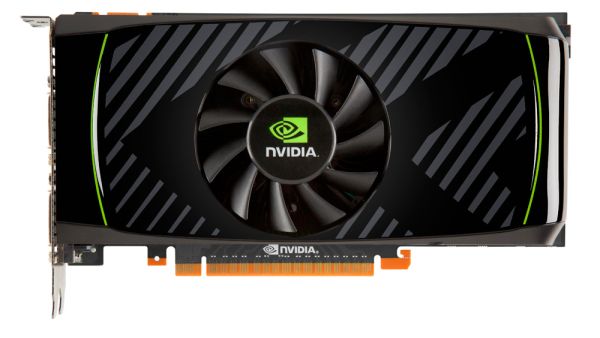NVIDIA's GeForce GTX 550 Ti: Coming Up Short At $150
by Ryan Smith on March 15, 2011 9:00 AM ESTThroughout the lifetime of the 400 series, NVIDIA launched 4 GPUs: GF100, GF104, GF106, and GF108. Launched in that respective order, they became the GTX 480, GTX 460, GTS 450, and GT 430. One of the interesting things from the resulting products was that with the exception of the GT 430, NVIDIA launched each product with a less than fully populated GPU, shipping with different configurations of disabled shaders, ROPs, and memory controllers. NVIDIA has never fully opened up on why this is – be it for technical or competitive reasons – but ultimately GF100/GF104/GF106 never had the chance to fully spread their wings as 400 series parts.
It’s the 500 series that has corrected this. Starting with the GTX 580 in November of 2010, NVIDIA has been launching GPUs built on a refined transistor design with all functional units enabled. Coupled with a hearty boost in clockspeed, the performance gains have been quite notable given that this is still on the same 40nm process with a die size effectively unchanged. Thus after GTX 560 and the GF114 GPU in January, it’s time for the 3rd and final of the originally scaled down Fermi GPUs to be set loose: GF106. Reincarnated as GF116, it’s the fully enabled GPU that powers NVIDIA’s latest card, the GeForce GTX 550 Ti.
| GTX 560 Ti | GTX 460 768MB | GTX 550 Ti | GTS 450 | |
| Stream Processors | 384 | 336 | 192 | 192 |
| Texture Address / Filtering | 64/64 | 56/56 | 32/32 | 32/32 |
| ROPs | 32 | 24 | 24 | 16 |
| Core Clock | 822MHz | 675MHz | 900MHz | 783MHz |
| Shader Clock | 1644MHz | 1350MHz | 1800MHz | 1566MHz |
| Memory Clock | 1002Mhz (4.008GHz data rate) GDDR5 | 900Mhz (3.6GHz data rate) GDDR5 | 1026Mhz (4.104GHz data rate) GDDR5 | 902Mhz (3.608GHz data rate) GDDR5 |
| Memory Bus Width | 256-bit | 192-bit | 192-bit | 128-bit |
| RAM | 1GB | 768MB | 1GB | 1GB |
| FP64 | 1/12 FP32 | 1/12 FP32 | 1/12 FP32 | 1/12 FP32 |
| Transistor Count | 1.95B | 1.95B | 1.17B | 1.17B |
| Manufacturing Process | TSMC 40nm | TSMC 40nm | TSMC 40nm | TSMC 40nm |
| Price Point | $249 | ~$130 | $149 | ~$90 |
Out of the 3 scaled down 400 series cards, GTS 450 was always the most unique in how NVIDIA went about it. GF100 and GF104 disabled Streaming Multiprocessors (SMs), which housed and therefore cut down on the number of CUDA Cores/SPs and Polymorph Engines. However for GTS 450, NVIDIA instead chose to disable a ROP/memory block, giving GTS 450 the full shader/geometry performance of GF106 (on paper at least), but reduced memory bandwidth, L2 cache, and ROP throughput. We’ve always wondered why NVIDIA built a lower-performance/high-volume GPU with an odd number of memory blocks and what the immediate implications would be of disabling one of those blocks. Now we get to find out.
Launching today is the GTX 550 Ti, which features the GF116 GPU. As with GF114 before it, GF116 is a slight process tweak over GF106, using a new selection of transistors in order to reduce leakage, increase clocks, and to improve the card’s performance per watt. With these changes in hand NVIDIA has fully unlocked GF106/GF116 for the first time, giving GTX 550 Ti the responsibility of being the first fully enabled part: 192 CUDA cores is paired with 24 ROPs, 32 texture units, 384KB of L2 cache, a 192-bit memory bus, and 1GB of GDDR5.
The GTX 550 Ti will be shipping at a core clock of 900MHz and a memory clock of 1026MHz (4104MHz data rate), the odd memory speed being due to NVIDIA’s quirky PLLs. If you recall, GTS 450 was clocked at 783MHz core and 902MHz memory, giving the GTX 550 Ti an immediate 117MHz (15%) core clock and 124MHz (14%) memory clock advantage, with the latter coming on top of an additional 50% memory bandwidth advantage due to the wider memory bus (192-bit vs. 128-bit). NVIDIA puts the TDP at 116W, 10W over GTS 450. GF116 remains effectively unchanged from GF106, giving it a transistor count of 1.17B, with the power difference coming down to higher clocks and the additional functional units that have been enabled.
Unlike the GTS 450 launch, GTX 550 Ti is a more laid back affair for NVIDIA – admittedly this is more often a bad sign than it is a good one when it comes to gauging their confidence in a product. As a result they are not sampling any reference cards to reviewers, instead leaving that up to their board partners. As with GF104/GF114, GF116 is pin compatible with GF106, meaning partners can mostly reuse GTS 450 designs; they need only reorganize the PCB to handle a 192bit bus along with meeting the slightly higher power and cooling requirements. As a result a number of custom designs and overclocked cards will be launching right out of the gate, and you’re unlikely to ever see a reference card. Today we’re looking at Zotac’s GeForce GTX 550 Ti AMP, a factory overclocked card that pushes the core and memory clocks to 1000MHz and 1100MHz respectively. The MSRP on the GTX 550 Ti is $149 - $20 more than where GTS 450 launched at – while overclocked cards such as the Zotac model will go for more.

As was the case with the GTS 450, NVIDIA is primarily targeting the GTX 550 Ti towards buyers looking at driving 1680x1050 and smaller monitors, while GTX 460/560 continues to be targeted at 1920x1080/1200. Its closest competitor in the existing NVIDIA product stack is the GTX 460 768MB. The GTX 460 768MB has not officially been discontinued, but one quick look at product supplies shows that 768MB cards are fast dropping and we’d expect the 768MB cards to soon be de-facto discontinued, making the GTX 550 Ti a much cheaper to build replacement for the GTX 460 768MB. In the meantime however this means the GTX 550 Ti launches against the remaining supply of bargain priced GTX 460 cards.
AMD’s competition will be the Radeon HD 6850, and Radeon HD 5770. As is often the case NVIDIA is intending to target an AMD weak spot, in this case the fact that AMD doesn’t have anything between the 5770 and 6850 in spite of the sometimes wide performance gap. Pricing will be NVIDIA’s biggest problem here as the 5770 is available for around $110, while AMD has worked with manufacturers to get 6850 prices down to around $160 after rebate. Finally, to slightly spoil the review, as you may recall the GTS 450 had a deal of trouble breaking keeping up with the Radeon HD 5770 in performance – so NVIDIA has quite the performance gap to cover to keep up with AMD’s pricing.
| March 2011 Video Card MSRPs | ||
| NVIDIA | Price | AMD |
| $700 | Radeon HD 6990 | |
| $480 | ||
| $320 | Radeon HD 6970 | |
| $240 | Radeon HD 6950 1GB | |
| $190 | Radeon HD 6870 | |
| $160 | Radeon HD 6850 | |
| $150 | ||
| $130 | ||
|
|
$110 | Radeon HD 5770 |












79 Comments
View All Comments
Soldier1969 - Wednesday, March 16, 2011 - link
Poor mans card, come back when you get at least a 580 or better...valenti - Thursday, March 17, 2011 - link
Ryan, can you explain where the nodes per day numbers come from?I spend a fair amount of time hanging around folding sites, I can't think of anybody else that uses the nodes per day metric. Most people use PPD (points per day), easily gathered from a F@H statistics program such as HFM.net
I'm unsure how to convert nodes/day to PPD, if that is possible. In actual practice, I find that a 450 card nets almost 10,000PPD, while a 460 gets about 12,000. I prefer the 450, after taking into effect price and power needs.
You might want to search on "capturing a WU" to read about how to copy a protein's work files, allowing you to run the same protein for each card.
suddenone - Thursday, March 17, 2011 - link
How good this card is depends on what monitor you plan on using. Anyone that has a small monitor and plans to keep it for at least three years might be happy with this card. I am puzzled to see fps over 60 on a standard 60hz monitor. My gtx 460 ran fine until I upgraded to a 24 inch 1080p monitor. I sold the card on ebay and bought the gtx 570( big gun). The gtx 570 can run any of my games at over 30fps min with all effects at maximum. Peace out.ol1bit - Thursday, March 17, 2011 - link
I bought 2 460's 6 months ago it so. For 149 each, and they beat the 550 in every catigory.This is a bad launch by Nivida. Old product is faster at same price or lower.
meatfestival - Monday, March 21, 2011 - link
Not sure if it's already been posted, but although it does indeed use id Tech 4, Raven wrote a custom DX9 renderer for it.The multiplayer component (based on the Quake Wars fork of id Tech 4) is on the old OpenGL renderer.
ClagMaster - Friday, March 25, 2011 - link
The GF116 has much optimized and improved performance over that of the GT-450 it is destined to replace.However, the GTX-550 Ti is a low-end replacement for the GT-450 and is priced to much. I wished nVidia called it the GT-550 and reserved the Ti designation for something truly high performance.
For $20 more, I can get a ATI-6850 that gives me 25% more performance for 10% less power consumption.
chrcoluk - Friday, October 21, 2011 - link
I think people are been very harsh on the card.its slower than the older 460 on these benchmarks but the gap isnt a gulf and in addition peopel are completely discounting the power factor. The major problem with graphics cards today is they use too much power, intel have managed to reduce power load whilst increasing performance, yet nvidia cant do the same.
Also no considerations taken on what people are upgrading from, I currently have an 8800GT and am only considering upgrading, a 550 TI would double performance whilst using a little more power on load over the 8800GT and only a 3rd on idle. Buying a 460 would give me a bigger performance boost but I need to connect a 2nd power cable (wtf???) and it uses significantly more power than the 550, about 50% more. so for watts vs performance the 550 beats the 460. But it seems people on here and most other sites consider power consumption as 0 importance, maybe they dont pay their own power bills?
The 550 TI will have many sales because nvidia know most people dont upgrade every year but more likely 3+ years frequency so the 550TI doesnt have to beat the 460 it just has to be significantly better than DX9 and DX8 cards at a good price point whilst also not needing someone to maybe buy a fatter psu as well (not considered here when comparing prices). The 550TI will double my current performance, and I guess the 460 1 gig would be about an extra 20% or so on top of that. Amount of video ram is also important, texture heavy games will saturate 768meg so in those scenarios the 550 is a better choice than the 768 460 model.
xKerberos - Tuesday, January 17, 2012 - link
Oh finally someone who makes some sense! In my country, GTX460s are more expensive than GTX550 Tis and my overclocked Gigabyte 9800gt was struggling to run Battlefield 3 so I picked up an MSI GTX550 Ti with 1gb of ram and factory overclocked. It runs BF3 like a dream at high. And seeing how it munches on VRAM, I'm surprised how people with 768mb cards run that game.Granted I have a tiny 1280x1024 Dell UltraSharp 19" monitor so I don't need a high end card to max games out. My 9800gt was doing a fine job until BF3 came out. I also had to fork out for 8gb of ddr2 ram to run that beast properly.
Anyway what I like about my new card is it was cheap (half the price of GTX560, although at half the performance), it runs very cool (36C on idle in a warm tropical country! max 60C on load), very quiet and it does the job. I won't have to upgrade for a while yet!
UpStateMike - Wednesday, February 22, 2012 - link
I have to agree with this. About a month ago I began the project build to replace an ancient dinosaur that was maxed out and tired.I kept my good 630W ps, a 24" led 1080p viewsonic monitor, and a 9800 gtx card that I figured I could use in the new build.
I started with a new case - rosewill challenger, and build around an i5 Sandy Bridge 2500k put into asus p8z68-vpro mb. I have 8gb of gskill ddr3 1333 at the moment.
Now that this is all up and running, instead of my old system being the performance bottleneck of the video card, the card is now the bottleneck.
I began by trying to cheap out and stay at $80 range, and OC the cards mentioned here, but I liked the lower power use (I'm a medium gamer but I wanted a PC that could handle any game I want to get in the future) of the 550ti and although I'm at $120 for this card, my guess is when I go for my next upgrade phase in about 6 months or so, I can wait for a good deal to come along and get another one to SLI and another 8gb of memory.
So for me, this is a big upgrade that I can build on to SLI and get to where I should be happy for the next couple of years. I do more photography editing and whatnot so this greatly helps me with that and I can still game as I get some time. I can appreciate that the differences are minor for anyone that has bought a card in the last year, but coming from a 9800gtx I'm very happy.